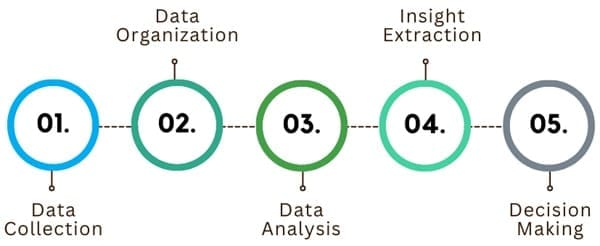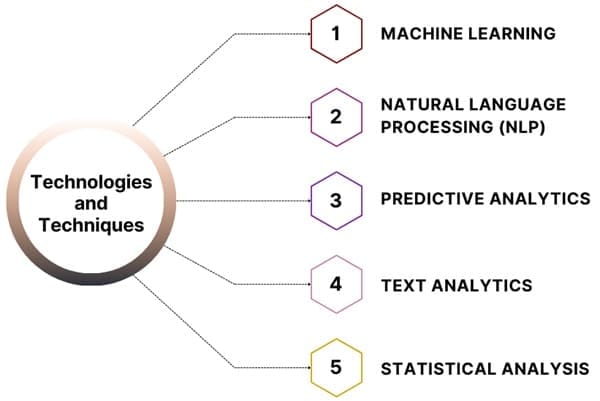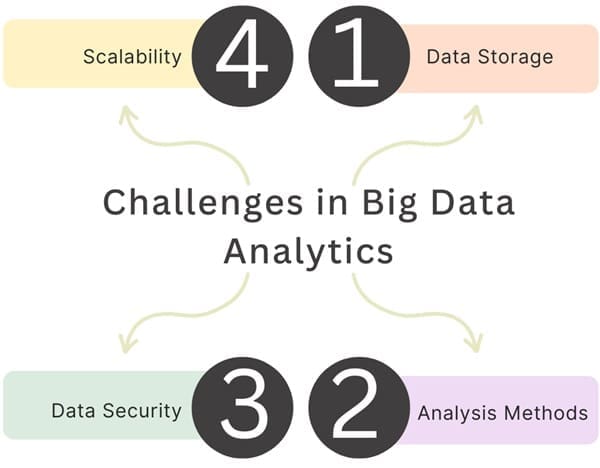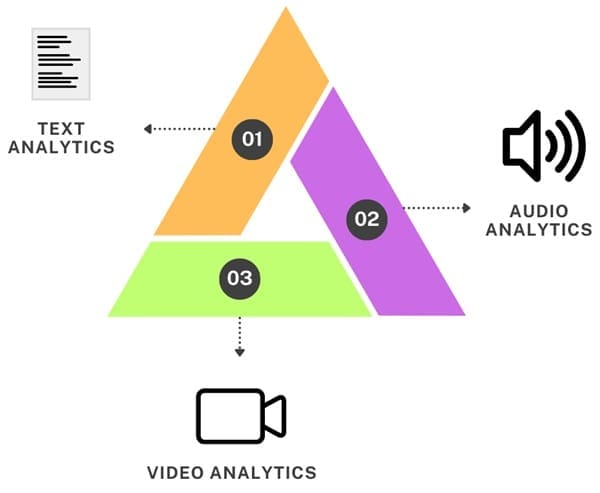Big Data Analytics is a process that involves examining large and complex data sets to uncover hidden patterns, correlations, and other valuable insights. This field employs various techniques and technologies to manage, analyze, and derive meaningful information from data that is too vast or complex for traditional data-processing software.
The core goal is to transform raw data into actionable intelligence that can guide decision-making and problem-solving.
Table of contents
What is Big Data Analytics?
Big data analytics involves several steps:
- Data Collection: Gathering data from various sources, which could be structured or unstructured.
- Data Organization: Structuring the data in a way that makes it easier to analyze.
- Data Analysis: Using various techniques to interpret the data and uncover patterns.
The purpose of these steps is to transform raw data into actionable insights. This process often uses advanced methods like machine learning, text analytics, and predictive analytics to handle data that traditional methods may struggle with.
Key Components of Big Data Analytics

- Data Collection and Integration: The first step involves gathering data from diverse sources, including transactional systems, IoT devices, social media platforms, and customer feedback. Data integration involves combining data from different sources into a cohesive dataset.
- Data Storage: Managing large volumes of data requires advanced storage solutions. We use technologies such as Hadoop Distributed File System (HDFS) and cloud storage services like AWS S3 to handle and store big data efficiently.
- Data Processing and Analysis: This involves cleaning, structuring, and analyzing data to extract valuable insights. Techniques such as machine learning, data mining, and statistical analysis are applied to uncover patterns and trends.
- Data Visualization and Reporting: After analyzing the data, we present the results through visualizations such as charts, graphs, and dashboards. Tools like Tableau, Power BI, and D3.js help in transforming complex data into easy-to-understand visuals.
- Predictive and Prescriptive Analytics: Predictive analytics involves forecasting future trends based on historical data, while prescriptive analytics provides recommendations for actions to achieve desired outcomes.
Process of Big Data Analytics

- Data Collection: Gathering vast amounts of data from diverse sources, including social media, sensors, transactional records, and more.
- Data Organization: Structuring and categorizing data to make it manageable. This often involves cleaning the data to remove inaccuracies and inconsistencies.
- Data Analysis: Applying various analytical methods to extract meaningful patterns and insights from the data. Techniques include statistical analysis, machine learning, and data mining.
- Insight Extraction: Interpreting the results to identify trends, patterns, and correlations that can inform business decisions or solve problems.
- Decision Making: Using the insights gained to make informed, data-driven decisions that can lead to improved outcomes and efficiency.
Technologies and Techniques in Big Data Analytics

- Machine Learning: Algorithms that enable computers to learn from and make predictions or decisions based on data. For instance, predictive models can forecast future trends or customer behaviour.
- Natural Language Processing (NLP): Techniques for analyzing and interpreting human language. This includes sentiment analysis, text mining, and language translation.
- Predictive Analytics: Methods used to forecast future trends based on historical data. This can help businesses anticipate customer needs or market changes.
- Text Analytics: The process of analyzing unstructured text data to extract useful information. This involves text mining, sentiment analysis, and topic modelling.
- Statistical Analysis: Using mathematical techniques to summarize and interpret data. This includes hypothesis testing, regression analysis, and correlation analysis.
Importance of Big Data Analytics
Big Data Analytics has become a crucial asset for organizations and governments. Its importance can be highlighted in several key areas:
- Business Optimization: By analyzing large datasets, businesses can gain insights into customer preferences, market trends, and operational efficiencies. This allows for better decision-making, targeted marketing, and improved customer service.
- Economic Impact: Big Data Analytics is shaping new business models and driving innovation. It helps companies understand market dynamics and consumer behaviour, leading to more effective strategies and competitive advantages.
- Healthcare Advancements: In medicine, big data analytics can identify patterns in patient data, predict disease outbreaks, and improve treatment plans. This leads to better patient outcomes and more efficient healthcare systems.
- Smart Cities: Data from smart devices and social networks can be used to enhance urban living. This includes optimizing public transport, improving traffic management, and enhancing public services.
- Government Services: Governments use big data to improve public services and policy-making. Data-driven insights can enhance education, public safety, and infrastructure planning.
Challenges in Big Data Analytics

Despite its benefits, big data analytics faces several challenges:
- Data Storage: The rapid growth of data from sources like IoT devices and social media necessitates efficient storage solutions. Traditional storage methods are often inadequate for handling such massive volumes of data. Advanced storage technologies, such as distributed file systems and cloud storage, are required.
- Analysis Methods: Developing accurate and efficient analytical methods is challenging due to the complexity and volume of data. Data scientists need to select appropriate tools and techniques to handle inconsistencies and uncertainties in the data.
- Data Security: Analyzing vast amounts of data makes it crucial to ensure the security and privacy of sensitive information. Encryption, authorization, and authentication techniques protect data, but managing them in big data contexts can be complex.
- Scalability: As data grows, analytical systems must scale accordingly. The pace at which data expands often outstrips the speed of data processing hardware, creating scalability challenges. Solutions like parallel computing and distributed processing are employed to address this issue.
Also See: Lean Six Sigma Certification Programs, Tulsa, Oklahoma
Categories of Big Data Analytics

Big Data Analytics can be categorized based on the type of data being analyzed:
- Text Analytics: This involves extracting valuable information from unstructured text data. Techniques include Natural Language Processing (NLP), information extraction, and relation extraction. Applications include sentiment analysis, fraud detection, and customer feedback analysis.
- Case Study: Social media analytics for product defect detection can reveal issues from user posts and reviews. Tools like WEKA and frameworks like SMART are used for analyzing textual data.
- Audio Analytics: Also known as speech analytics, this process involves analyzing audio data to extract insights. Applications include call centre performance evaluation, healthcare diagnostics, and threat detection.
- Case Study: Analyzing call centre recordings using tools like Google Speech API and Hadoop to improve customer service performance and identify service issues.
- Video Analytics: This refers to the analysis of video data to gain insights from visual content. Techniques include monitoring video streams for surveillance, customer behaviour analysis, and real-time threat detection.
- Case Study: Video analytics for vehicle tracking and surveillance can identify incidents or detect violations. Tools like OpenCV and Kestrel are used for video analysis.
Applications of Big Data Analytics
Business Intelligence: Companies use big data analytics to gain insights into customer behaviour, market trends, and operational efficiencies. This helps in making informed decisions, improving customer experiences, and optimizing business processes.
Healthcare: In the healthcare industry, big data analytics is used to predict disease outbreaks, personalize treatment plans, and enhance patient care. Analyzing patient data helps in identifying trends and improving health outcomes.
Finance: Financial institutions use big data to detect fraud, manage risks, and optimize trading strategies. Analytics helps in identifying unusual patterns and making more informed investment decisions.
Retail: Retailers use big data to understand customer preferences, optimize inventory, and personalize marketing campaigns. Analyzing purchasing patterns and customer feedback helps in enhancing the shopping experience.
Smart Cities: Big data analytics is used to improve urban planning, manage traffic, and enhance public services. Data from sensors and social media helps in making cities more efficient and livable.
Future of Big Data Analytics
Advancements in technologies such as artificial intelligence, machine learning, and quantum computing are shaping the future of big data analytics. Emerging trends include the integration of big data with edge computing, enhanced data privacy measures, and the development of more intuitive data visualization tools.
As data continues to grow exponentially, the ability to harness its power will drive innovation and transform industries.
Final Words
Big Data Analytics is transforming how organizations and governments leverage data to make informed decisions and drive innovation. By understanding and overcoming the challenges associated with data storage, analysis, security, and scalability, and by applying sophisticated analytical techniques, stakeholders can unlock the full potential of their data.
As technology advances and data continues to grow, the role of big data analytics in shaping our future will only become more significant.

About Six Sigma Development Solutions, Inc.
Six Sigma Development Solutions, Inc. offers onsite, public, and virtual Lean Six Sigma certification training. We are an Accredited Training Organization by the IASSC (International Association of Six Sigma Certification). We offer Lean Six Sigma Green Belt, Black Belt, and Yellow Belt, as well as LEAN certifications.
Book a Call and Let us know how we can help meet your training needs.



















